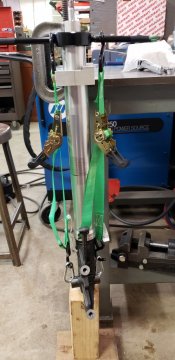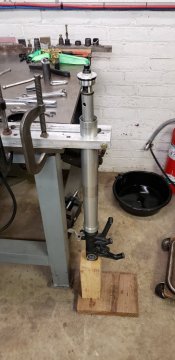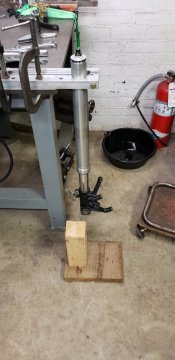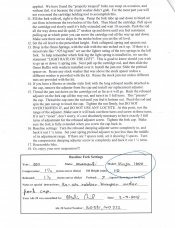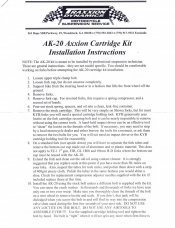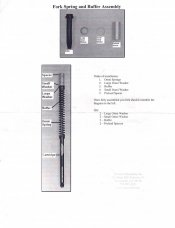No, given the fact that the AK20s displace more oil than the stock damper unit, when you fill the oil level to 100mm per instructions, the fork tube is full. 99mm would have oil spilling over the top. With basically no air in the fork it actually pulls a partial vacuum at extension. I think some of the older forks had a provision to add air for some air spring effect, but I've never thought about it since it doesn't apply. I do know air is a terrible gas for spring effect due to huge changes in volume (pressure) due to heat expansion. Thats why they use nitrogen for example in a Penski or similar shock. Even if you lowered the oil level to allow some air, I can't see it doing much in the inch you might gain, unless it was pressurized. And then to do it right you'd need a bladder.You haven’t touched on oil level from my last post, and have you considered its effect on slowing fork compression ?
-
WOULD YOU LIKE TO BE ABLE TO POST? REGISTER FOR COG MEMBERSHIP
All registration must be done through the club's main webpage: To register / join COG, click here
For instructions to convert to full membership, click here
-
Can't post after logging to the forum for the first time... Try Again - If you can't post in the forum, sign out of both the membership site and the forum and log in again. Make sure your COG membership is active and your browser allow cookies. If you still can't post, contact the COG IT guy at IT@Concours.org.
You are using an out of date browser. It may not display this or other websites correctly.
You should upgrade or use an alternative browser.
You should upgrade or use an alternative browser.
Suspension
- Thread starter redline
- Start date
Welllll, maybe that’s the reason your static and rider sag is incorrect?No, given the fact that the AK20s displace more oil than the stock damper unit, when you fill the oil level to 100mm per instructions, the fork tube is full. 99mm would have oil spilling over the top. With basically no air in the fork it actually pulls a partial vacuum at extension. I think some of the older forks had a provision to add air for some air spring effect, but I've never thought about it since it doesn't apply. I do know air is a terrible gas for spring effect due to huge changes in volume (pressure) due to heat expansion. Thats why they use nitrogen for example in a Penski or similar shock. Even if you lowered the oil level to allow some air, I can't see it doing much in the inch you might gain, unless it was pressurized. And then to do it right you'd need a bladder.
Setting the oil level isn’t dependent on the amount the cartridges displace in the fork. It’s set by filling the fork up to a certain level of the compressed fork with the spring out. In this case it would be 100mm or 4” below the top edge of the fully compressed fork. Now extend the fork… it will be the full stroke , 113mm or about 4.5”; now the air gap is 8.5”.. Drop the spring in, screw the top on and there is an air cavity captured above the oil which is an “air spring” and iirc it’s pressure squares as its volume is halved.
I 100% guarantee you that if you filled your extended forks to the top with oil, left the springs out and closed the forks up by screwing the tops on, the forks would hold the bike and you on the bike with the forks topped out, as they are hydraulically locked.
Last edited:
After a bit more thought there is air introduced in the tube after assembly of the damper rod to the cap. Then dropping the cap down to thread it in place youve probably got about 4 inches of air. So there is no vacuum like i said before.Now extend the fork… it will be the full stroke , 113mm or about 4.5”; now the air gap is 8.5”
Agreed. Kind of obvious, I don't know how much effect the air has on top the oil.I 100% guarantee you that if you filled your extended forks to the top with oil, left the springs out and closed the forks up by screwing the tops on, the forks would hold the bike and you on the bike with the forks topped out, as they are hydraulically locked.
Last edited:
That’s the reason there’s an oil height spec. You can make a fork more compliant with a lower oil height ( higher number) or make it stiffer with a lower number . It’s an old trick to fine tune the “spring”.Yep, never thought about that way. I guess then you'd have to play with different levels of "air".
Agreed. Kind of obvious, but filling with air never crossed my mind.
ar
Are you sure you had the fork compressed / spring out when you set your oil level?I just edited my last post
Yes. The pictures don't show the oil level. It's hard to tell but in the picture where you should see the oil, the lower tube is extended about a half inch. But it was filled with the tube completely collapsed and to the proper level. I lower the bottom tube a half inch in order to fish out the damping rod without overflowing oil. The picture with the strap shows the lower tube up off the block as the spring is compressed. I know its hard to see but you'll have to take my word for it.
Spring was out. When dropping in the spring, the oil comes to the top of the tube.
Spring was out. When dropping in the spring, the oil comes to the top of the tube.
Attachments
Yes. The pictures don't show the oil level. It's hard to tell but in the picture where you should see the oil, the lower tube is extended about a half inch. But it was filled with the tube completely collapsed and to the proper level. I lower the bottom tube a half inch in order to fish out the damping rod without overflowing oil. The picture with the strap shows the lower tube up off the block as the spring is compressed. I know its hard to see but you'll have to take my word for it.
Spring was out. When dropping in the spring, the oil comes to the top of the tube.
I don't think that's possible. The pictures hold the facts.
Pic 1 = all the guts are in the fork, you've compressed the fork spring with the holding tool screwed into the holes in the preload tube. To do so, the spring is already on the assy.
Pic 2 You have now screwed the top onto the cartridge/spring/preload tube assy and removed the tool. You can now see the preload tube and the holes that the tool was interfacing with. You can see that the externally adjustable preload is screwed all the way down too. The outer fork tube is slid all the way down over the inner tube (slider). The fork is compressed, all the guts are assembled, YET no oil is spilling out or even visible.
Pic 3 Now you have dropped the slider down and screwed the cap onto the outer tube, completing the assembly. Assuming there's 113mm of slider showing, you have AT LEAST that much air space over the oil.
Memory is fleeting, but a picture is worth 1000 words.
There you go again barking up the wrong tree. Just because you can't see the oil in the picture doesn't mean it doesn't have the proper oil level. Since it does have the proper oil level it also has the proper "AIR" level. It is a fixed amount and the same as any other concours14 with AK20's. It seems to work just like the designers intended but the air spring can't be broken out to measure how much effect it has. I'm sure you could figure it out mathematically but that doesn't translate into feel.
I was thinking about all this and came up with an experiment we could try on Ted's bike. If we could super charge the air in the fork and then jump off a 10 ft cliff landing squarely on the front wheel, I wonder if the fork would "Deisel ".


I was thinking about all this and came up with an experiment we could try on Ted's bike. If we could super charge the air in the fork and then jump off a 10 ft cliff landing squarely on the front wheel, I wonder if the fork would "Deisel ".
Are you saying you put the oil in AFTER you Installed the spring/ preload spacer and screwed the top onto the piston rod? How did you fill / measure the 100mm height ? I have done this a few times and understand the process. Btw the 86 to 93 concours did have shraders to fill the air chamber.There you go again barking up the wrong tree. Just because you can't see the oil in the picture doesn't mean it doesn't have the proper oil level. Since it does have the proper oil level it also has the proper "AIR" level. It is a fixed amount and the same as any other concours14 with AK20's. It seems to work just like the designers intended but the air spring can't be broken out to measure how much effect it has. I'm sure you could figure it out mathematically but that doesn't translate into feel.
I was thinking about all this and came up with an experiment we could try on Ted's bike. If we could super charge the air in the fork and then jump off a 10 ft cliff landing squarely on the front wheel, I wonder if the fork would "Deisel ".
Last edited:
I haven't had the pleasure of servicing a C-14 shock yet. So reading this to learn.
It sounds like Laker is filling the tube with oil and setting the level to 100mm. (with the spring removed/fork collapsed)
He then drops in the AK-20 cartridge and spring.
,,, When he drops those in (with the fork still compressed), the AK20 / spring displace so much oil that the level rises to the top of the upper fork tube?
Ride safe, Ted
It sounds like Laker is filling the tube with oil and setting the level to 100mm. (with the spring removed/fork collapsed)
He then drops in the AK-20 cartridge and spring.
,,, When he drops those in (with the fork still compressed), the AK20 / spring displace so much oil that the level rises to the top of the upper fork tube?
Ride safe, Ted
… and then he drops the slider down and extends the fork, the air space is established. That makes sense. Now I’m wondering if / how when he pumped the air out. I never had the oil level come up so high while installing the springs that the oil would spill out, but i may have partially extended the fork at that point to prevent that. When I mentioned oil level earlier, I understood lakers answer to mean the forks were extended.I haven't had the pleasure of servicing a C-14 shock yet. So reading this to learn.
It sounds like Laker is filling the tube with oil and setting the level to 100mm. (with the spring removed/fork collapsed)
He then drops in the AK-20 cartridge and spring.
,,, When he drops those in (with the fork still compressed), the AK20 / spring displace so much oil that the level rises to the top of the upper fork tube?
Ride safe, Ted
The cartridge is bolted in place prior to oil.He then drops in the AK-20 cartridge
I did it all per instructions, specifically steps 10,11 and 12. (the rest of it too but these steps address oil). I thought the pic of the fork guts would be good to help explain.How did you fill / measure the 100mm height ? I have done this a few times and understand the process.
I've flushed mine 4 or 5 times on top of the initial installation. Plus, I did somebody else's concours and my sons 1000 ninja. So, I do understand the process.
It took me 2 hours to get this new printer/scanner to scan. I've had it for 6 months and this is the first scanning I've done. What a pain! And then I'd scanned them all as pdfs, so went back and did them again in jpeg.
Attachments
If you are like me the next time you use the scanner it will be like starting over againThe cartridge is bolted in place prior to oil.
I did it all per instructions, specifically steps 10,11 and 12. (the rest of it too but these steps address oil). I thought the pic of the fork guts would be good to help explain.
I've flushed mine 4 or 5 times on top of the initial installation. Plus, I did somebody else's concours and my sons 1000 ninja. So, I do understand the process.
It took me 2 hours to get this new printer/scanner to scan. I've had it for 6 months and this is the first scanning I've done. What a pain! And then I'd scanned them all as pdfs, so went back and did them again in jpe
Glad to be of assistance with your scanner! I do have one remaining question though… everything is perfect, by the book . But you only have .075” difference between your static and rider sag. WHY?The cartridge is bolted in place prior to oil.
I did it all per instructions, specifically steps 10,11 and 12. (the rest of it too but these steps address oil). I thought the pic of the fork guts would be good to help explain.
I've flushed mine 4 or 5 times on top of the initial installation. Plus, I did somebody else's concours and my sons 1000 ninja. So, I do understand the process.
It took me 2 hours to get this new printer/scanner to scan. I've had it for 6 months and this is the first scanning I've done. What a pain! And then I'd scanned them all as pdfs, so went back and did them again in jpeg.
.75mm.But you only have .075” difference between your static and rider sag. WHY?
That's what I was asking you!
Hopefully with everyone getting the slacker, we can compare sags.


